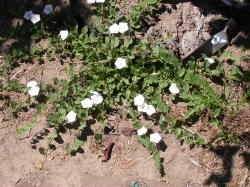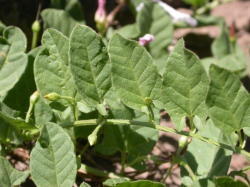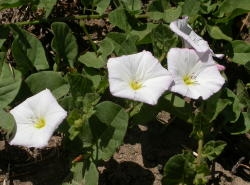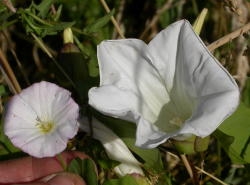
Field bindweed grows prostrate until coming in contact with other plants or structures. It is often found growing up and over shrubs and other plants in its path.
Flowers are trumpet shaped, pink to white in color, with 5 fused petals. Field bindweed has two leaf bracts that grow from ½ to 1 inch below the flower, and is a key identification characteristic. Flowering is indeterminate, so flowers will continue to develop along growing stems until first frost.
Favorable environments: Favorable environment notes:Field bindweed can be found flourishing in dry gravelly field soils. It prefers rich, fertile soils with moderate moisture, but can tolerate long periods of drought. In moist, warm growing conditions, the leaves are much larger and vines more robust than when drought stressed. Because of its versatility, it is found in many common agricultural plantings, roadsides, railways and pastures.
Dissemination:Field bindweed grows and spreads from seed and from an extensive rootstock. Plants are prolific seed producers, with an average plant producing over 500 seeds. Within a month, the seed coat has matured and become impervious to water. With such an extensive root system of lateral and vertical roots, a plant can spread radially more than 10 feet in a growing season.
Management link: Of interest:Field bindweed’s aggressive vine habit makes it imperative to control, while its deep root system makes it extremely difficult to control. Its name is derived from the Latin word convolvo which means "to twine", and arvense which means "of the field". There are two other weedy species that are sometimes confused with field bindweed; hedge bindweed and wild buckwheat . Hedge bindweed is less aggressive than field bindweed and typically is found only in perennial crops and on undisturbed field margins. It can, however, be extremely competitive with the crop, especially in high fertility and irrigated conditions. Hedge bindweed can be distinquished from field bindweed by examining the flower; unlike field bindweed there are no bracts on the stem below the flower. Wild buckwheat leaves are very similar to field bindweed and has a twining habit. It is usually found in cultivated fields and is easily distinguished from field and hedge bindweed because its flowers are small and inconspicuous.

 be described as having an arrow James Altland, USDA-ARS " width="250" height="187" />
be described as having an arrow James Altland, USDA-ARS " width="250" height="187" />



OSU College of Agricultural Sciences
430 Strand Agriculture Hall
Corvallis, Oregon 97331
![]()
![]()
![]()
![]()
![]()